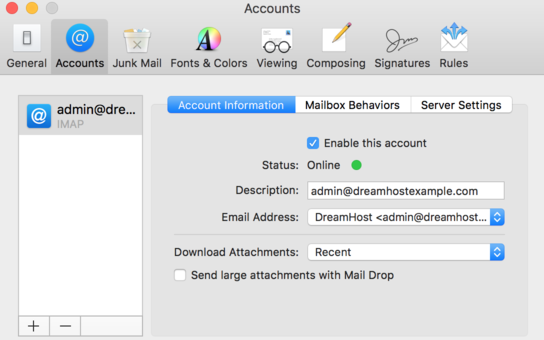

#Where to change email password on mac how to#
Here’s how to recover Mac password, using another account you have a password to: Or, if your mother/brother/girlfriend/dog ever use your computer to log in to their personal accounts (yes, now you owe them a thank you). Lucky you if you have more than one user account on your Mac. Once you get to the reset screen, input a new password two times, create a hint, and save. Agree to the option to reset with Apple ID and enter wrong login credentials three times to be able to create the new password. To make a go of this, click on the question mark next to the password field that you see on the login screen. Otherwise, you can enable it in System Preferences > Users & Groups > Allows user to reset password using Apple ID. The option should be available by default. If you have an Apple ID tied to your user account on Mac, you can use it to reset password from the login window. You’ll be able to use the new password after a restart. Lastly, change Mac password, create a hint to easily recollect it in future, and click save.Go to the main hard drive and choose your user account.Type “resetpassword” (in one word) and click Return.Next, choose Disk Utility > Continue > Utilities Terminal.Wait for the loading bar to appear on the screen while your Mac boots to Recovery. Turn off your computer and hold the power button + Command R.For such cases, there’s Apple’s Recovery Mode. There are no password hints and you can’t call it to mind, even though you’ve already tried to enter all pet names. You forgot Mac password and can’t access any of your accounts. Your account password and login keychain password now match again.Hope this is just a “what-if” for you, but let’s imagine it happened. Log in to your account using your new password.Choose Log Out from the Apple menu to return to the login screen.Press the Delete key, then click Delete References. If you don't see a Reset My Default keychain button, close the preferences window and select the “login” keychain from the left side of the Keychain Access window. Choose Preferences from the Keychain Access menu, then click the Reset My Default Keychain button in the preferences window. After you enter your new password, Keychain Access creates an empty login keychain with no password.Open Keychain Access, which is in the Utilities folder of your Applications folder.If you didn't see an alert about your login keychain, or you see other messages asking for your old password, reset your keychain manually: Just click the Create New Keychain button in the alert. This is expected, because the passwords for your user account and login keychain no longer match. Select ”My password doesn't work when logging in,” then click Next and follow the onscreen instructions for your user account.Īfter resetting your password and logging back in to your account, you might see an alert that the system was unable to unlock your login keychain.

In the Terminal window, type resetpassword, then press Return to open the Reset Password assistant pictured above.When you see the macOS Utilities window, choose Utilities > Terminal from the menu bar.Restart again, then immediately hold down Command-R or one of the other macOS Recovery key combinations until you see the Apple logo or a spinning globe.If you can't log in with your new password after restarting your Mac, take these additional steps: Determine whether to create a new login keychain.Follow the onscreen instructions to create a new password, then click Reset Password when done.Use uppercase characters, and include the hyphens. The password field changes to a Recovery Key field. If you don't see the message after three attempts, FileVault isn't on. At the login screen, keep entering a password until you see a message saying that you can reset your password using your Recovery Key.If FileVault is turned on and you have a FileVault Recovery Key, you can use that key to reset your password.


 0 kommentar(er)
0 kommentar(er)
